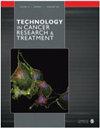Clinical Value of Human Endogenous Retrovirus-H Long Terminal Repeat Associating 2 (HHLA2) in Small Cell Lung Cancer
IF 2.8
4区 医学
Q3 ONCOLOGY
引用次数: 0
Abstract
Objective: Human endogenous retrovirus-H long terminal repeat associating 2 (HHLA2) is a new immune checkpoint in the B7 family, and the value of HHLA2 in small cell lung cancer (SCLC) is unknown. Methods: We retrospectively detected HHLA2 expression by immunohistochemistry in SCLC patients. Moreover, plasma biomarkers of SCLC were detected retrospectively. Results: Seventy-four percent of SCLC patients exhibited HHLA2 expression. HHLA2 staining was localised within the nucleus of SCLC cells, while no staining was detected in normal lung tissue specimens. The correlation between HHLA2 expression and clinical factors was also analysed. Limited stage (LS) SCLC was more common than extensive stage (ES) SCLC among patients with HHLA2 staining. SCLC patients without metastasis had higher HHLA2 expression than SCLC patients with metastasis. HHLA2 expression was more frequently detected in the group with a tumour size greater than 5 cm than in the group with a tumour size less than 5 cm. The proportion of patients with HHLA2-positive staining was greater in the stage III and IV SCLC groups than in the stage I and II SCLC groups. A high proportion of SCLC patients with HHLA2-positive staining had a survival time <2 years. Neuron-specific enolase (NSE), CEA and Ki-67 levels were measured. The NSE level in the HHLA2-positive group was significantly greater than that in the HHLA2-negative group. The CEA and Ki-67 levels did not significantly differ between the HHLA2-positive and HHLA2-negative patients, nor were age, sex, smoking status, nodal metastasis status, Karnofsky Performance Scale (KPS) score, or Ki-67 expression score. HHLA2-positive SCLC patients had higher tumour stages and shorter 2-year survival times than HHLA2-negative patients did. Conclusion: The new immune molecule HHLA2 may be an ideal clinical biomarker for predicting SCLC progression and could serve as a new immunotherapy target in SCLC.人类内源性逆转录病毒-H 长末端重复序列关联 2 (HHLA2) 在小细胞肺癌中的临床价值
目的:人类内源性逆转录病毒-H长末端重复关联2(HHLA2)是B7家族中的一个新的免疫检查点,HHLA2在小细胞肺癌(SCLC)中的价值尚不清楚。研究方法我们通过免疫组化方法回顾性检测了SCLC患者中HHLA2的表达。此外,还回顾性检测了 SCLC 的血浆生物标志物。结果74%的SCLC患者有HHLA2表达。HHLA2染色定位于SCLC细胞核内,而在正常肺组织标本中未检测到染色。研究还分析了HHLA2表达与临床因素之间的相关性。在有HHLA2染色的患者中,局限期(LS)SCLC比广泛期(ES)SCLC更常见。无转移的SCLC患者的HHLA2表达高于有转移的SCLC患者。肿瘤大于 5 厘米的患者比肿瘤小于 5 厘米的患者更常检测到 HHLA2 表达。在III期和IV期SCLC组中,HHLA2染色阳性的患者比例高于I期和II期SCLC组。在HHLA2染色阳性的SCLC患者中,有很高比例的患者存活时间为2年。对神经元特异性烯醇化酶(NSE)、癌胚抗原(CEA)和Ki-67水平进行了测定。HHLA2阳性组的NSE水平明显高于HHLA2阴性组。HHLA2阳性和HHLA2阴性患者的CEA和Ki-67水平无明显差异,年龄、性别、吸烟状况、结节转移状况、卡诺夫斯基表现量表(KPS)评分和Ki-67表达评分也无明显差异。与HHLA2阴性患者相比,HHLA2阳性SCLC患者的肿瘤分期更高,2年生存时间更短。结论新的免疫分子HHLA2可能是预测SCLC进展的理想临床生物标记物,并可作为SCLC的新免疫疗法靶点。
本文章由计算机程序翻译,如有差异,请以英文原文为准。
求助全文
约1分钟内获得全文
求助全文
来源期刊
CiteScore
4.40
自引率
0.00%
发文量
202
审稿时长
2 months
期刊介绍:
Technology in Cancer Research & Treatment (TCRT) is a JCR-ranked, broad-spectrum, open access, peer-reviewed publication whose aim is to provide researchers and clinicians with a platform to share and discuss developments in the prevention, diagnosis, treatment, and monitoring of cancer.

 求助内容:
求助内容: 应助结果提醒方式:
应助结果提醒方式:


